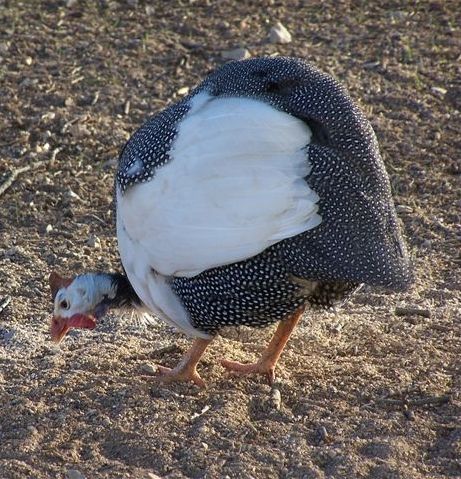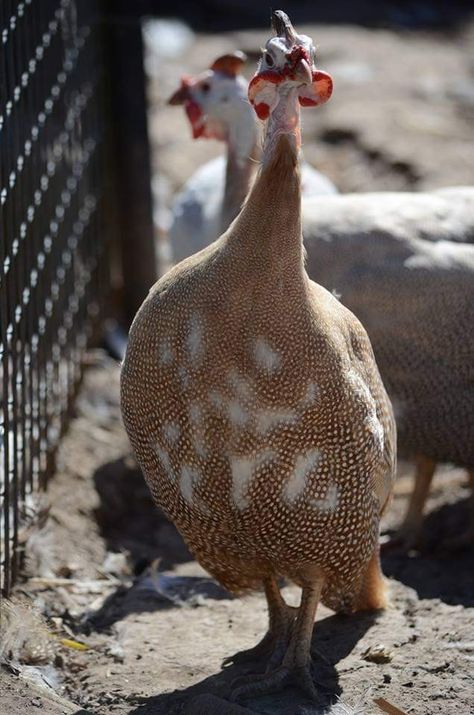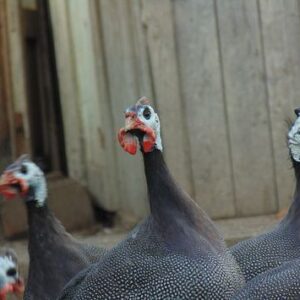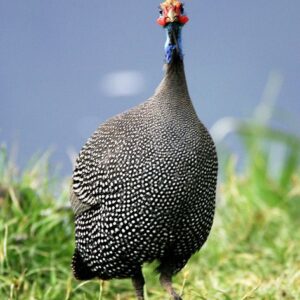The Pied Guinea Fowl is a visually striking variety of guinea fowl, recognized for its unique black and white plumage pattern. Unlike the traditional pearl-spotted guinea fowl, the Pied variety has a bold contrast of dark feathers with large white spots scattered across its body, creating a dramatic and appealing look. This attractive bird is a domestic breed that has been favored for its beauty, hardiness, and practical benefits, making it a popular choice for farms, backyards, and ornamental bird enthusiasts.
Physical Characteristics
Pied Guinea Fowl are medium-sized birds with rounded, robust bodies covered in a mix of dark, glossy feathers and irregular white spots, which give them their “pied” appearance. Their head is bare, adorned with bright blue and red skin, and topped with a small bony casque. Like all guinea fowl, they have strong legs built for foraging on the ground, and their beak is short and curved, perfect for picking up seeds, insects, and small invertebrates. Their striking pattern makes them stand out in any flock, while their hardy nature ensures they thrive in various environments.
Behavior and Social Traits
Pied Guinea Fowl are highly social and active birds that live in flocks. They communicate with loud, repetitive calls that can alert the group to potential threats or disturbances. Their vocalizations also serve as a means of maintaining cohesion within the flock. These birds are ground-dwelling and spend much of their time foraging for food, such as insects, seeds, and other small food sources. While they can fly short distances to escape predators or find shelter, they generally prefer running. They are often kept in free-range systems, where they can roam and forage naturally.
Habitat and Care
Pied Guinea Fowl are adaptable and hardy, able to thrive in a range of environments, from grasslands and open fields to farms and backyards. They are well-suited to free-range systems, where they can forage for food, but they can also be kept in enclosures or coops with sufficient space. They require minimal maintenance, needing only clean water, shelter, and protection from predators. Their ability to withstand various weather conditions and their low maintenance make them ideal for small farms, homesteads, and properties looking for natural pest control.
Reproduction and Breeding
During the breeding season, Pied Guinea Fowl form pairs or small groups for mating. Females lay clutches of 12–15 eggs in ground nests, which they conceal in grass or vegetation to protect them from predators. The eggs hatch after an incubation period of around 26–28 days, and the chicks, called keets, are precocial. They can move, forage, and follow their parents shortly after hatching but need protection and warmth in the early stages of life. As they grow, the keets’ distinctive white spots begin to appear, and they eventually develop into adult Pied Guinea Fowl.
Benefits and Uses
Pied Guinea Fowl are valued for both their ornamental beauty and practical benefits. The striking appearance of their plumage makes them a popular choice for decorative purposes, especially in backyard flocks or ornamental bird collections. These birds are also highly beneficial for pest control, as they are natural foragers and can help reduce insect populations, including ticks, grasshoppers, and other small pests. Additionally, like other guinea fowl, they produce lean, flavorful meat and nutritious eggs, though they are typically raised more for their aesthetic qualities and pest control abilities than for production.
Popularity and Conservation
Pied Guinea Fowl, like other domesticated guinea fowl varieties, are widely bred and sought after for their unique appearance and utility. They are commonly found on small farms, homesteads, and properties looking for natural ways to manage pests. Although not considered endangered, their populations in the wild are threatened by habitat destruction and hunting. Domesticated varieties are kept and bred specifically for ornamental purposes and for their dual-purpose value.
Conclusion
The Pied Guinea Fowl is a stunning and versatile bird, combining beauty with practicality. Its distinctive black and white plumage, social nature, and ability to control pests make it a valuable and attractive addition to any farm, garden, or backyard. Whether kept for ornamental purposes, pest control, or both, the Pied Guinea Fowl is a hardy and rewarding species that adds both charm and functionality to any property.








Reviews
There are no reviews yet.